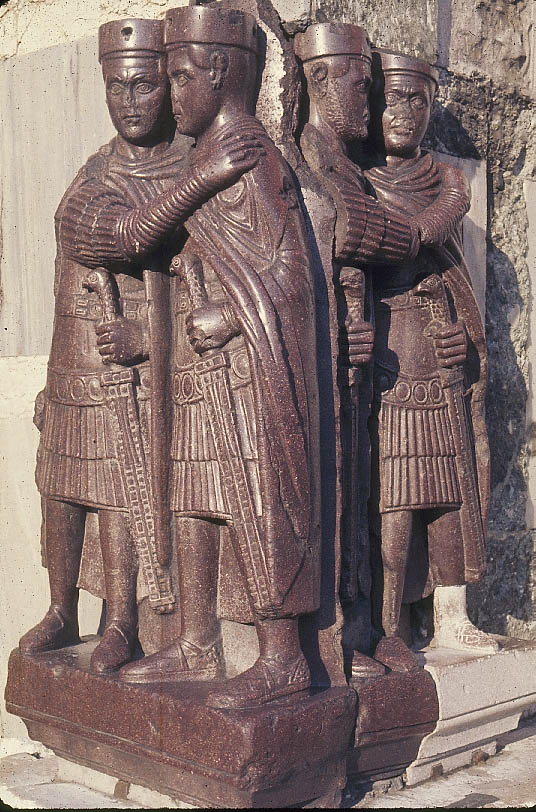NOVEMBER 20/21: EARLY CHRISTIANITY AND LATE
ANTIQUITY: AN END OR A BEGINNING?
READINGS (Monday class, November 20): the Confessions, pp. 3-40. Be
sure to continue to the webnotes on
Augustine's Confessions.
READINGS (Tuesday night class, November 21): the Confessions, pp.
3-40, 52-65, 72-103, 133-54. Be sure to continue to the webnotes on Augustine's Confessions.
Summary: The term, LATE ANTIQUITY, refers to the
period that saw the collapse of the Roman empire in western Europe
and the emergence of a Christian culture in the Mediterranean world.
Roughly speaking, it spans the third, fourth and fifth centuries.
Against this backdrop of political and cultural change, we will
consider
the artistic changes of late antiquity, as exemplified by the Arch of
Constantine and the mosaics of Piazza Armerina. Then, we will survey
representative examples of early Christian art from the catacombs of
Rome to illuminated manuscripts and the mosaics of fifth- and
sixth-century churches in
Rome and Ravenna. We will see how the Christians made the Roman and
Jewish past their own by borrowing from Roman imperial art and
interpreting the Old Testament as a prefiguration of the coming of
Jesus.
HISTORICAL OUTLINE AND IMPORTANT WORKS OF ART AND
ARCHITECTURE
1. CRISIS OF THE THIRD AND FOURTH CENTURIES
-Emperor DIOCLETIAN (284-305) established the TETRARCHY
through the division of the empire into an eastern
and western part, with an emperor (an "Augustus") and an appointed
successor (a "Caesar") in each part. This was an effort to guard
the frontiers, improve the administration and ensure an orderly
succession.
-Emperor CONSTANTINE (306-337)
- 312: Constantine's conversion to Christianity was followed
by a victory over his rival, Maxentius, at the Milvian Bridge outside
Rome
- 313: the EDICT OF MILAN proclaimed religious
toleration for Christians
- 330: dedication of CONSTANTINOPLE, a new capital
in the East
2. LATE ANTIQUE ART: THE ARCH OF CONSTANTINE AND THE MOSAICS
OF PIAZZA ARMERINA
-The Arch of Constantine was dedicated to Constantine by the Senate
after the victory at the Milvian Bridge; the roundels and the large
reliefs in the attic were stripped from second-century imperial
monuments ( SPOLIA ), while the friezes, the figures of captives
and some other elements were carved for the arch in the early fourth
century.
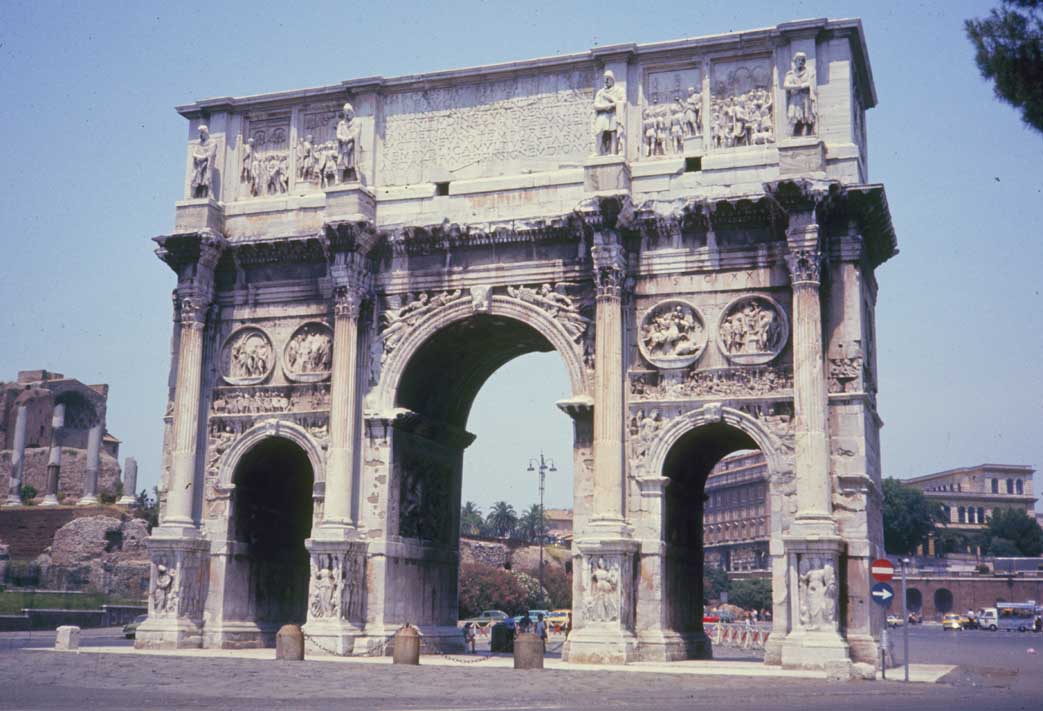
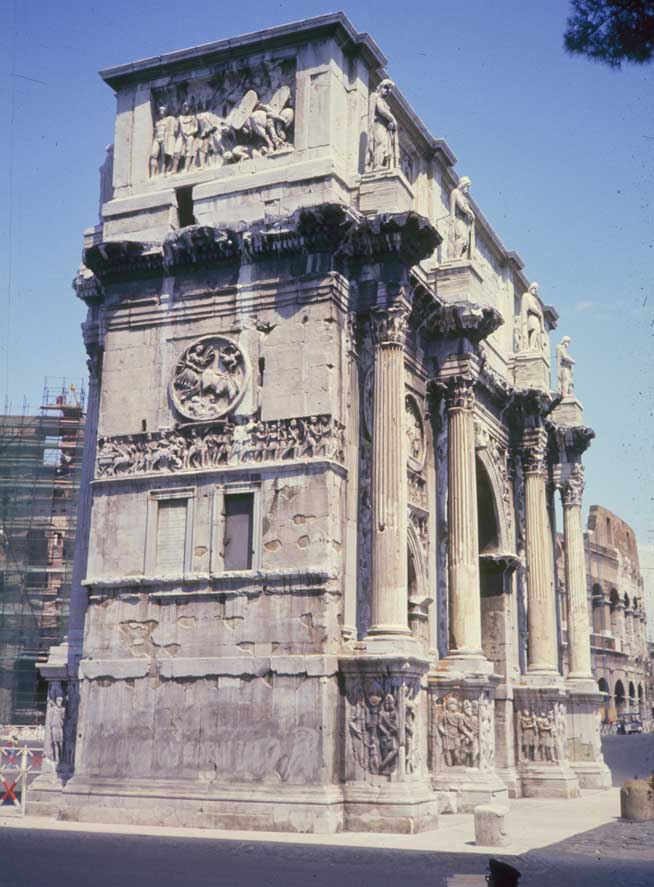
-Piazza Armerina is the site, in Sicily, of a large villa
(a country estate) decorated with pavement MOSAICS, probably
of the early fourth century. Subjects include hunting scenes,
chariot races, scenes of children hunting and at play, and mythological
episodes. The mosaicists may have been from north Africa, and
the owner may have supplied animals for the games in Rome.
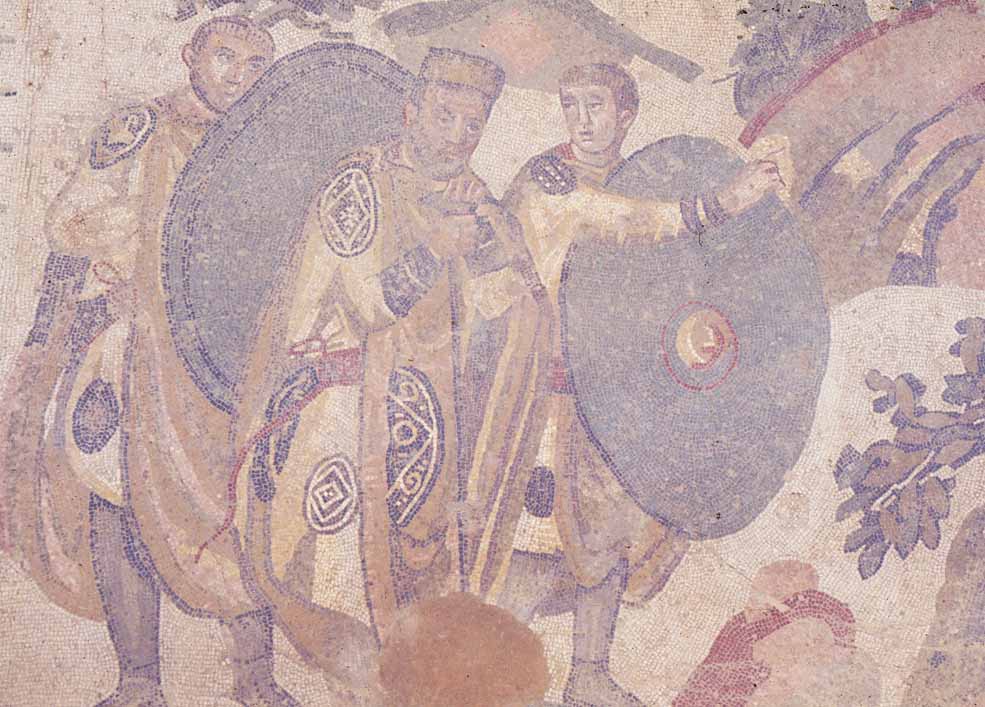
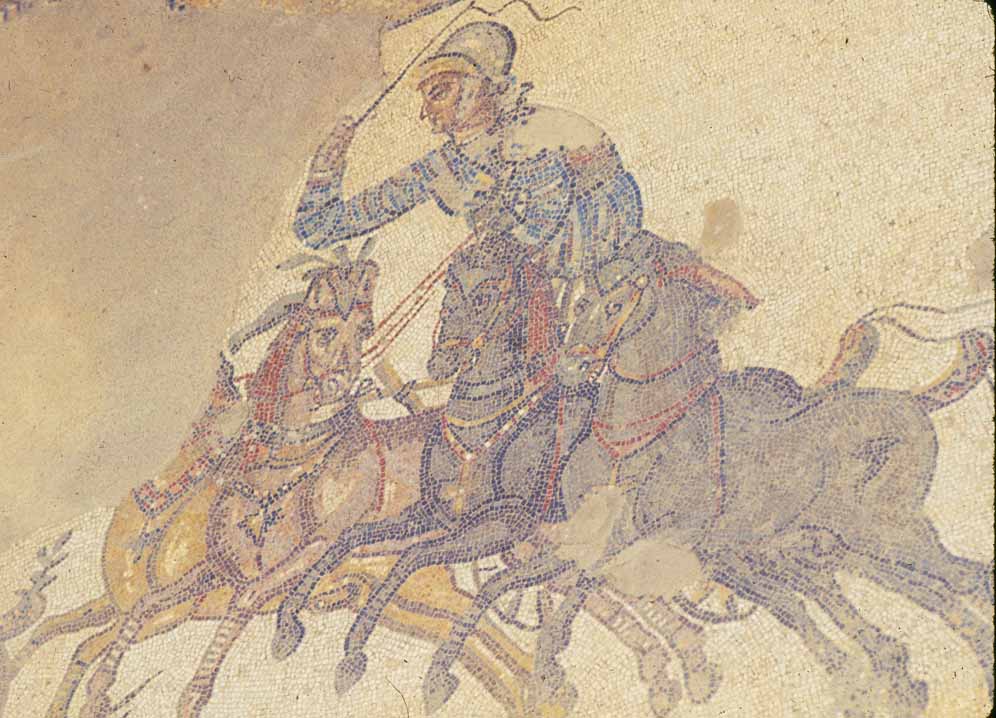
3. FACTORS INFLUENCING THE CHANGES IN LATE ANTIQUE ART
- The wars and political instability of the third century were a
precondition for artistic change. They brought about a breakdown
in artistic production in Rome. This allowed new traditions to
become important and, thus, favored change.
- The growing importance of the provinces and of the military
forces, largely recruited from the provinces, encouraged the adoption
of provincial styles in Rome itself. (Compare the reliefs of the
second-century monument of the emperor Trajan at Adamklissi
in the Balkans)
- Under the tetrarchy and in the late Empire, the emperor's role
was transformed. His links with the divine were emphasized,
imperial ceremonial grew more elaborate, and the gulf between the
emperor and his subjects widened.
- There was an increasingly otherworldly emphasis in late antique
culture; the NEOPLATONIST philosophy of Plotinus gained
importance, and religions which promised personal salvation and
spiritual benefits to individual believers won adherents.
4. EARLY CHRISTIAN ATTITUDES TOWARDS THE ARTS
-practical constraints on the early Christian use of the arts
- need for secrecy in the face of periodic persecutions
- limited resources of the early Christian communities
-ideological reasons for early Christian attitudes towards the arts
- Old Testament prohibitions: "Thou shalt not make unto thee any
graven image, or any likeness of any thing that is in heaven above, or
that is in the earth beneath, or that is in the water under the earth."
(Exodus 20:4)
- association of statues with pagan IDOLATRY
- otherworldly orientation and MILLENARIANISM:
"Immediately after the tribulation of those days shall the sun be
darkened, and the moon shall not give her light, and the stars shall
fall from heaven,
and the powers of the heavens shall be shaken. And then shall
appear
the sign of the Son of man in heaven: and then shall all the tribes of
the earth mourn, and they shall see the Son of man coming in the clouds
of heaven with power and great glory. And he shall send his
angels
with a great sound of a trumpet, and they shall gather together his
elect
from the four winds, from one end of heaven to the other...Verily, I
say
to you, This generation shall not pass, till all these things be
fulfilled."
(Matthew 24: 29-31, 34)
5. EARLY CHRISTIAN ART BEFORE THE CONVERSION OF CONSTANTINE
- the early third-century painted
Christian house church and baptistry at DURA EUROPOS, a
frontier town on the Euphrates river where there was also a Jewish
synagogue with painted scenes from the Bible
(illustrated
description
of Dura Europos ).
- the CATACOMBS in Rome: underground burial places for the
early Christians of Rome, with paintings - sometimes in the form of
" ABBREVIATED IMAGES" - in the CUBICULA, rooms where
wealthier families had their burials
- SARCOPHAGI: carved stone coffins
- AQUILEIA: a Roman town in northern Italy, the site of a
church with pavement mosaics of the early fourth century
6. EARLY CHRISTIAN SYMBOLISM
-TYPOLOGY: Events from the history of the Jewish people in the
Old Testament were interpreted by Christians as foreshadowing events in
the life of Jesus, in the life of the church and in the Last
Judgement. The story of JONAH is a good example:
"For as Jonah was three days and three nights in the whale's
belly; so shall the Son of Man be three days and three nights in the
heart of the earth." (Matthew 12: 40).
JONAH is represented in catacomb paintings and statuettes , and
on carved sarcophagi and pavement mosaics.
-The early Christians adapted some pagan figures for Christian
subjects, e.g., the figure of ENDYMION, a mythological figure
who was loved by the Moon and granted the gift of eternal sleep, was
used for Jonah, as a symbol of resurrection and eternal life.
7. CHRISTIAN ART AFTER THE CONVERSION OF THE EMPEROR
CONSTANTINE
-the development of a Christian architecture (
Illustrated description and discussion of early Christian architecture
)
-BASILICA (e.g.,
OLD ST. PETER'S
, Rome)
-CENTRALLY PLANNED CHURCHES (MARTYRIA, baptistries,
palace churches), e.g., STA. COSTANZA, Rome (the mausoleum of
Constantina, the daughter of Constantine), the BAPTISTRY OF THE
ORTHODOX , Ravenna
-changes in the figural arts (painting, mosaic and sculpture)
-the appropriation of imperial iconography, e.g., the apse
mosaics in Roman churches (Sta. Costanza and Sta. Pudenziana) and
the SARCOPHAGUS OF JUNIUS BASSUS (c. 359); compare the
images of the GOOD SHEPHERD in the catacombs with the later
mosaic in the fifth-century imperial MAUSOLEUM of GALLA
PLACIDIA in Ravenna
-the revival or survival of classicizing styles - more
three-dimensional and more lifelike images, e.g., four panels from
IVORY DIPTYCHS : the
SYMMACHUS IVORY
, the Munich ivory of the RESURRECTION and ASCENSION
, the ST. MICHAEL IVORY
8. ARTISTIC PROGRAMS IN EARLY CHURCHES: TWO EXAMPLES
SANTA MARIA MAGGIORE, ROME
This
church was built and decorated with mosaics under Pope Sixtus III
(432-40).
In the nave, the mosaics are set in square panels along the upper
walls;
they tell stories from the Old Testament, and their artists were
influenced
by the narrative scenes on Trajan's column and those in early
illuminated
manuscripts. At the east end of the nave, the last scene shows MELCHISIDEK
offering bread and wine to ABRAHAM (Genesis 14: 18-20).
Christians interpreted this incident as a foreshadowing of their own
offering of
bread and wine in the mass, the Christian worship service.
On the arch that frames the apse, the mosaics
were arranged in rows, and they appear to combine Old and
New Testament figures. Here, the symbolic meaning of the figures and
scenes is emphasized, and the rows of scenes resemble those on Roman
triumphal arches, like the Arch of Galerius in Salonika. Throughout the
church, the architecture and mosaics imitate works of Roman imperial
art, and
send the message that the popes have replaced the emperors as holders
of
power in Rome, and, for the people of Christian Rome, the Bible has
taken the place of Roman history.
<>SAN VITALE, RAVENNA
By the choice and arrangement of
subjects, the mosaics on the walls surrounding the altar offer a
symbolic
commentary on the central act of the Christian mass: the offering
of bread and wine by the congregation in commemoration of Jesus'
offering
of bread and wine at the Last Supper, and the mystical transformation
of the bread and wine into the body and blood of Jesus in commemoration
of his sacrificial death on the cross.
Above the altar, angels support the vault of
heaven, and a LAMB, the animal of sacrifice in the Old
Testament, symbolizes Jesus' sacrifice. On the upper part of the side
walls, the EVANGELISTS , the authors of the four GOSPELS
(the New Testament accounts of the life of Jesus), are placed above
figures from the Old Testament (Moses, Isaias and Jeremiah). This
reflects the Christian view that the New Testament completes or
fulfills the history and prophecies of the Jewish people, as presented
in the Old Testament. Scenes from the Old Testament on the side walls
represent offerings: Abraham's offering of his son Isaac, Abel's
offering of a lamb and - on the same altar - Melchisidek's offering of
bread and wine.
In the apse, the theme of offering is extended
to more recent events in the history of the Christian church. In the
lower part of the apse, the emperor, JUSTINIAN, and the
empress, THEODORA , offer bread and wine, as if taking part in
the ceremony in the church itself. In the half-dome of the apse, the
martyr, St. Vitalis, receives a crown for his offering of his life, and
bishop
Ecclesius offers Jesus a model of the church he had begun. In this way,
the planners of the program and its artists express the continuity of
Christian
history, from the history of the Jewish people in the Old Testament,
through
the life of Jesus and the growth of the Christian church, to the
continuing commemoration of those events in the Christian liturgy and
the Christians’ hopes for eternal life.
WEBLINK TO IMAGES
OF SAN VITALE (Dr. Allen Farber's European Medieval Art course
SUNY, Oneonta
******************************************************************************
FOOD FOR THOUGHT: In pagan and Christian art of late antiquity, a range
of styles appears, and stylistic choices carry meaning. Discuss
the way style contributes to the meaning of a contemporary
television advertisement or music video, and compare this with the
use of style in late antiquity.
******************************************************************************
FOR A BASIC INTRODUCTION TO THE BIBLE and "BIBLE HIGHLIGHTS": CLICK HERE!
| NOTICE:
All images on this page are my own, copyright James D'Emilio
. These images must not be reproduced for profit or commercial
use, nor may they be reproduced in any media (print, CD etc.) for sale
or public distribution without my express consent. Any
reproduction of any of these images on another website for non-profit,
educational purposes must be accompanied by an acknowledgement of my
copyright (
Copyright: James D'Emilio ) linked
to my homepage:
http://shell.cas.usf.edu/~demilio/index.htm |
<>NOVEMBER 20/21/22 (AUGUSTINE'S
CONFESSIONS)
SCHEDULE OF READINGS (Monday/Wednesday)
SCHEDULE OF READINGS (Tuesday night)
RETURN TO HUM 2211
